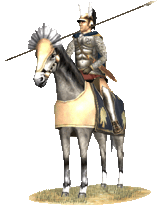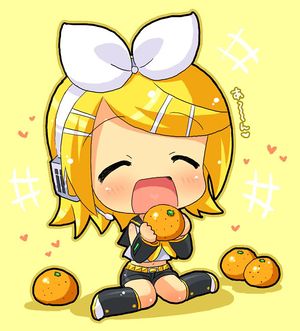User:Romaioktonos/Rin Kagamine
This page is a work in progress |
| Rin Kagamine | |

| |
| Basileus Arches Seleukeias | |
| Assumed position | |
| January 2013 | |
| Preceded by | Peithon |
|---|---|
| Succeeded by | Antiochos I Soter |
| Place of Residency | Seleukeia (Deceased) |
| Born | December 27, 1993 at Pella |
| Assassinated | February 29, 2019 at Demetrias |
| Birth name | Seleukos (or Seleuke), surname not confirmed |
| Nationality | Makedonian |
| Political party | Keraunopolemos Party |
| Affiliation | formerly Makedonia, Seleukid Dynasty |
| Spouse | None |
| Children | None |
| Profession | Somatophylax to Megas Alexandros, later Basileus |
| Religion | Greek Orthodox, combined with a trace of Horse Fetish or Road Roller Zealotry |
Rin Kagamine, more well-known as Seleukos I Nikator, is a Hellenistic general who was one of Alexandros III's Somatophylakes. Seleukos also took for himself the largest (albeit the poorest, considering the fact that the eastern provinces save for Baktria were dirt poor) portion of Alexandros III's empire, taking it in a hard fight involving shifting alliances including the friendship and eventual hostility between Seleukos and Ptolemaios I Soter. Unfortunately, Seleukos's dream of reuniting the empire like any other Diadochoi was shattered, when Seleukos was assassinated by Ptolemaios Keraunos, who was unrelated to Ptolemaios I Soter. In a sense, Seleukos and Ptolemaios was much like Jefferson and Adams.
It is theorized that Demetrios Pharou took up the idea of wearing the headgear to associate himself with the Hetairoi. For the picture of Demetrios Pharou, go here or here. Seleukos I Nikator does not feature on Europa Barbarorum for obvious reasons.
The Struggle for Power[edit | edit source]
Main Article: Diadochoi
Unlike Ptolemaios I Soter, who was given a position as a satrap to Aigyptos and stayed that way, Seleukos was given a more rough path. Seleukos was appointed the satrap of Babylonia when Perdikkas was the regent of the empire. Seleukos was given the command of the Hetairoi, not so surprising since Seleukos ALWAYS wore a headgear that resembled the plumed helmet that the Hetairoi wore. Seleukos's domain was bordered briefly by Peukestas and the province of Persis, who withdrew from what would be a grueling struggle for power to go to Karchedon. The thing was that Babylonia was a good province, but the problem was that the military was weak at the time. Seleukos, however, did not own Babylon itself, a thing that would change when Seleukos won over the Babylonian priests with the gift of road rollers which did wonders in repairing the road to the temple, so much that the priests dedicated the road rollers to Marduk. Once Seleukos was in place, Jesus effectively supplanted Marduk thanks to Seleukos's meddling in the synhedrion of the Babylonian religion.
Seleukos' problems were largely the product of the machinations of Antigonos I Monophthalmos, who continued to murder rivals believing that such actions will secure the Lebensraum for peach farmers. Even as Seleukos attempted to keep a good relationship with Antigonos, Antigonos probably didn't care, and despite Seleukos' tendency to roll over enemies with the Road Rollers, Seleukos decided to abandon the satrapeia, taking only 50 hetairoi to Aigyptos, where Ptolemaios I Soter maintained a highly secure position having repelled Antigonos' advances.
As an admiral to Ptolemaios I Soter, Seleukos informed Kassandros and Lysimachos about Antigonos I Monopthalmos, who now had the primacy in the Diadochoi world. As such, it allowed Ptolemaios I Soter to carry out her policy: externally being friendly to major rival powers, while internally inciting other rival powers against the big power. As such, the relationship between Antigonos and Ptolemaios was superficially good. Kassandros and Lysimachos demanded that Antigonos let Seleukos return as a satrap to Babylon, and Antigonos responded by invading and occupying the southern part of Hellas. Ptolemaios gave Seleukos 100 ships to attack Rhodos after Antigonos allied with it in return for the unlimited access to the treasury, and along with Lysimachos, who was also concerned about the future of the Lelouch Project, attacked Rhodos but the fleet was too small. However, Seleukos did make an ally of Asandros and the province of Karia, which was immediately attacked by the Antigonid forces.
Seleukos, along with Ptolemaios, personally led the Ptolemaic troops against Demetrios I Poliorketes, defeating her him in the Battle of Gaza. After this, Seleukos returned to Babylon, and established the mighty Arche Seleukeia.
Seleukos, ό Νικατωρ[edit | edit source]
Eastern Provinces[edit | edit source]
The easier part (albeit longer) of the campaign was against the eastern provinces, now rife with lack of civil order ranigng from disillusionment to outright rebellion. Seleukos then proceeded with the Hellenization project, something that Alexandros was not able to do due to her his quick death retirement in Persepolis. Of course, the eastern provinces were dirt poor, despite the fact that Hellenistic period did support the Keleuthos Bombykike connected all the way to China. Seleukos took little time suppressing all revolts with the Sacred Road Rollers rededicated to Jesus (after it had been dedicated to Marduk by the Babylonian priests), and some natives, fearing that they were offending Jesus, just surrendered. The war for the eastern provinces led to the clash between Seleukos and Chandragupta Maurya, in which Seleukos did poorly and failed take India. However, much like the tale of Gilgamesh and Enkidu, they became buddies, and Seleukos ceded Taxila and the southeastern region of the empire to Chandragupta, who gave Seleukos in return 500 elephants, even though Seleukos wanted 10,000 male horses. The Sacred Road Rollers from Thebai once again aided Seleukos, owning the infantry lines of the Eleutheroi and the Indoi with ease, even though some of them had to be repaired after the Battle of Taxila.
The Parni, known also as Pahlavan, were nomads who wielded RPG while in horseback, much like what Alexandros had to fight in Skythia. Fortunately for Seleukos, they were just nomads who had little desires for an empire, at least while Seleukos was basileus. However, Seleukos did pacify the Parni and raids on places such as Hekatompylos and Antiocheia-Margiane.
Hegemony over Anatolia[edit | edit source]
“Vegeta! What does the scouter say about Pergamon's silver level?”
– Nappa
“It's... 9000.”
– Vegeta on Nappa
“Aww! I wanted to hear 1006!”
– Nappa on Vegeta
Seleukos' second chance of expansion came in the form of Battle of Ipsos, where Seleukos personally dealt with Antigonos. With the temporary collapse of the Antigonids, Lysimachos took Pergamon and installed in there a treasury of 9 thousand silver talants to serve as backup funds for the Lelouch Project. Seleukos did not miss the opportunity to seize that away, and invaded Anatolia to take the Antigonid holdings, then shifted to the Kingdom of Makedon when Antigonos' heir, Demetrios I Poliorketes transferred to Makedon. Lysimachos was defeated at Copendion, leaving Seleukos as the uncontested, or at least, the strongest power in Anatolia. In fact, Philetairos of Tieion surrendered to Seleukos the entire asset in Pergamon, including the 9000 silver talents, filling the Seleukos' treasury largely depleted in war. This was very welcome, since the war between the Seleukidai and Ptolemaioi would persist, and the extra cash certainly helped to pay generals.
Here comes the ahistorical if, What if Seleukos kept a tight control over Anatolia? Chances are that it would prevent the formation of the Attalid Kingdom of Pergamon, since Philetairos was used to large autonomy. However, the if does have its own condition that Seleukos pay attention to Anatolia, which didn't happen since Seleukos was fighting against Ptolemaios. But what Seleukos did do was to develop mines and built roads in Anatolia to exploit it, since the wars in the East and the cost of maintaining even a small garrison in major cities cost Seleukos 100 gold talents, and just maintaining the troops cost 300 silver talents a year.
The predecessor to the Syrian Wars[edit | edit source]
“Alright, why am I thrown in this skirmish? I am not a good general!”
– Amu Hinamori on Skirmish between Ptolemaios I Soter and Seleukos I Nikator
“Well, believe in yourself! You can win battles like you can draw or be honest!”
– Some Guardian Character on Amu Hinamori
“Ok. What am I paying you for? Don't just sit there, get yourself in the frontlines commanding troops!”
– Seleukos I Nikator on Amu Hinamori
Of course, then came the predecessor of the Syrian Wars: After Seleukos built the Keleuthos Bombykike to connect India and China to Antiocheia instead of Hierosolyma and Alexandreia, the friction between former friends, Ptolemaios and Seleukos, was inevitable. However, neither one was willing to wage a full war: Seleukos wanted to go take a look at the horse-breeding land which is next to Parmenion's estate (that Parmenion never got to visit or use ever since Alexandros' retirement), while Ptolemaios was enjoying too much malt beer to be actually be full-heartedly wage war to take Syria. So the two camps launched raids against each other in the borders, resulting in innumerous inconclusive skirmishes that developed into a full war after their successors took over.
The largest battle of the predecessor of the Syrian Wars was caused by the Seleukid invasion of northern Ioudaia, led by the Misthophoros Strategos Amu. Amu was largely undermotivated, since Amu didn't even know what job to take, and ended up being hired ad hoc by Seleukos. Against Amu was none other than Yuki Nagato, who led the Galatian buddies (including the dreaded Tindanotae) of the Ptolemaioi, and they met at Samaria. The Ptolemaioi Klerouchoi were more than a match for the Seleukid incursion, which was largely Misthophoroi, not surprising as it was led by a Misthophoros who fled as soon as Yuki ordered the charge by the Tindanotae. However, Seleukos sent the army as a diversion, which drew Yuki's attention long enough for Seleukos to put undue pressure upon the Ptolemaioi held cities of Anatolia, such as Tarsos and Side.
Seleukos and Ptolemaios wagered the control of the Keleuthos Bombykike and the provinces of Syria and Ioudaia respectively, but since both were more interested in enjoying what they had, neither were aggressively pushing against one another. However, the successors, who were used to having a large territory, would aggressively push against each other, since they wanted more. Seleukos meanwhile conquered Bostra and Palmyra, which weren't too wealthy but militarily somewhat beneficial, and immediately started to build roads, which bolstered trade and would have done more if Ptolemaioi and Seleukidai weren't fighting but rather trading with one another, especially since Seleukos gave birth to the Mille Feuille industry in Syria.
Internal Policies[edit | edit source]
Seleukos ensured that the Hellenes came first, and the others later. However, Seleukos also kept close ties with the Babylonian priesthood, who now converted to Greek Orthodoxy and worshipped Jesus. Seleukos improved the Keleuthos Basilike Persike that was once owned by Darius III, and used the road rollers to establish it as a part of the Keleuthos Bombykike. Antiocheia was heavily fortified, and establishment of mines in the Anatolian mountainsides gave Seleukos a good income, which was necessary to cover the expenses of maintaining a huge empire. Like Ptolemaios, Seleukos established Klerouchiai and openly welcomed the Galatai to serve as Klerouchoi, but Seleukos' program was no match in size of that of Ptolemaios. Since Seleukos stayed in Aigyptos, Seleukos saw Ptolemaios II Philadelphos committing incest much as the Aigyptian pharaohs did, and this might have contributed to some rumors that Seleukos and Hephaistion engaged in incest that might have been homosexual. O.o
Seleukos wasn't too popular with the mainland Hellenes largely because Seleukos represented what was the Arche Persike. In fact, the approval rating poll held in Athenai returned a mere 18% approval rating for Seleukos (compared to 69% for Ptolemaios). One of the Athenaioi interviewed by the pseudoname of Euripedes stated that he could not stand the idea of fellow Hellenes doing the proskynesis to a earthly King, as well as the fact that Argyraspidai were now organized the Athanatoi style (the number was controlled to be set to 10,000 at all times, although reforms of successors such as Antiochos III according to some records have divided the Argyraspides corps to the Phalangitai corps and the Thorakitai corps).
You are not entitled to view results of this poll before you have voted.
If you said yes, chances are that you are one (or more) of the following
- Hellen living in the Arche Seleukeia
- Socialist
- Christian
- Fluffy
- South Korean
- Persian Defector
- Philiaponikos who believe Seleukos is Japanese
- Parmenion
- Pyrrhos Aiakides
- Pope Benedict XVI
- Road Roller Manufacturer
If you said no,
- Iaponikos
- Atheist
- Libertarian
- Chuck Norris
- Clint Eastwood
- Ronald Reagan
- Ronald McDonald
- Axis of Evil
- Perses
- Romaios
- Zarathustra
- Buddha
- Gandhi
- Milton Friedman
Religion[edit | edit source]
Seleukos did maintain Greek Orthodoxy as the prevalent religion of the domain, and by bribing, coaxing, and proselytizing to the Babylonian synhedrion, kept it going without creating much dissent. However, Seleukos did start the Cult of Road Rollers, which was very popular in cities connected by Seleukos' newly built roads. The Cult was given an official recognition in the city of Antiocheia, which was an obvious choice since it was the western end of the Keleuthos Bombykike. The Anchor was also an important part of the Seleukid mix of religions, since Seleukos claimed to have a birthmark that was shaped like an Anchor. In fact, it became the faction symbol, and successor kings also claim to have it, although this is probably propaganda. It was Seleukos that introduced the eggplant to Anatolia, which was quite convenient to a later king, Nikomedes IV, who used it as a personal symbol.
Of course, the diverse mix of religion in Seleukeia became even more colorful in the South, where the Seleukid archaeologists recovered sacred texts of Mohammed and in the East, where Chandragupta Maurya's foreign emissaries introduced Hinduism while Chandragupta's successor, Ashoka would go spread BUDDHISM.
But then, Greek Orthodoxy is still king. Koptic Christianity is an available choice in the Syrian regions.
Katoikiai[edit | edit source]
Katoikiai, or colonies for military settlers, was originally implemented by Athenai who came up with the system of Klerouchia (and the Emporiai). Unlike Ptolemaios whose land had VERY HIGH value, Seleukos had to use less valuable land even though the Tigris and the Euphrates were quite fertile. Therefore, it was common for Seleukos to stop at the Katoikia level, using STATE funds (God forbid that Libertarians read these words) to maintain the troops rather than use farmland that the settlers weren't so eager for. Even though Oikos meant the house and by extension, a family, the majority of the residents of the Katoikiai were single due to the fact that many people were castrated.
Famous Katoikiai
- Katoikiai of Syria and Syria Koile
- Kleouchiai of Tigris and Euphrates
- Seleukeia (A city largely made of Klerouchoi and government officials, meaning prostitutes WOULD have been in high demand but no, prostitution and adultery remained minimal)
- Katoikiai of Aria
- All 4 islands of Iaponia after taking it over in a coup d'etat using the 300 sacred Road Rollers of death. Oh, and Seleukos placed KOREAN GOVERNOR-GENERALS to rule Iaponia. Sucks to be Crypton in these days... Ishihara would disapprove... but then he's been run over by a road roller and can't complain.
- Baktria- Lost to Millya when Antiochos II Theos fought the Third Syrian War with Ptolemaios III Euergetes
Oikonomy[edit | edit source]
Seleukos owns most of the arable land of the Arche Seleukeia, and as such Seleukos ensures distribution to tenants, pushing them towards commercial farming rather than subsistence farming. Seleukos also set aside some of the land near the Mediterranean for oranges which served as the symbol of the Seleukid Church of Jesus while setting some more for grapes to convert to wine in attempts to use it to force Ptolemaios I Soter to a negotiation table. State ownership of land did not mean ownership of wealth: the agorai of the Arche Seleukeia are largely used by private merchants, who benefit from low commercial tax and the access to the Keleuthos Bombykike, recently improved by Seleukos' 300 Sacred Road Rollers from Thebai. Antiocheia boasts the largest Agora of the world, dwarving even the agora of Alexandreia/Mikatopolis owned by Ptolemaios due to the virtue of it being the western end of the Keleuthos Bombykike. Silk thus wasn't popular in mainland Hellas, even though smugglers often smuggled some into Aigyptos, which was widely popular with some of the nobles in Aigyptos.
Foreign trade with the Ptolemaioi is technically banned since the two sides were at war, but it did not stop smugglers. Also, trade with the Epeirotai flourished, where the Epeirote trading fleet under Eupatros Molossos under Pyrrhos Aiakides visited port cities like Side, Tarsos, and even Antiocheia for such luxury goods. It is known that Mille Feuille is quite popular with the Epeirotai, while the Makedones prefer Oranges.
Assassination[edit | edit source]
“
JeffersonPtolemaios stilllivesrules...”– Seleukos on Ptolemaios, oblivious to the fact that Ptolemaios retired earlier
The Seleukid hegemony over Anatolia have brought new changes, not excluding an hostility between Seleukos and Lysimachos over Anatolia, particularly Pergamon. The hostility led to the series of battles between Lysimachos, who was now threatened by Pyrrhos Aiakides from whom she took the throne of Makedonia for a short time. Having been pinned down, Lysimachos gambled by pushing towards Anatolia in an attempt to seize it, only to be killed and defeated at the Battle of Korou Pedion. Seleukos, although she established herhimself as the hegemon of Anatolia, such a change in power was not welcome in the Balkans: Arsinoos II, the sister brother of Ptolemaios II Philadelphos, decided to go side with another relative Ptolemaios Keraunos, who in turn invited Seleukos to the Balkans, only to assassinate her him on the feast halls. Ptolemaios Keraunos was later downed by the Keltoi, which infuriated Pyrrhos Aiakides as that robbed her him of the chance to absorb the Balkans in a stable position.
Rin Seleukos Facts[edit | edit source]
“Hail to thee, owner.”
– Fluffy on Seleukos
- Seleukos' breakfast consists of 9001 grams of Persikos Aigos, 9001 grams of Kuon, 9001 grams of pure heavy metals and radioactive materials including but not limited to Polonium, Uranium, Plutonium, Lead, Cadmium, Promethium, etc.
- Seleukos' exercise routine includes the lifting of Road Rollers repetitively. The engineers are frustrated by Seleukos' ability to do it while their pulleys can't.
- Seleukos consumes the souls of atheists, polytheists, libertarians, republicans, liberal democrats, and several centrists as snacks.
- Seleukos keeps Fluffy as the pet of the nation. It is rumored that Seleukos also keeps Fluffykins as well, but the supporters of Ptolemaios I Soter constantly challenge that notion, especially since Cats love Aigyptos. Pyrrhos Aiakides claim Fluffy, although due to the fact that Fluffy isn't of Molossian breed Pyrrhos quickly retract the claim.
- Chuck Norris fans are kept around in Seleukos' concentration camps just to be humiliated into sucking Seleukos' body parts.
- Seleukos CAN cause spontaneous combustion, 99% likely to convert an atheist libertarian to BBQ


